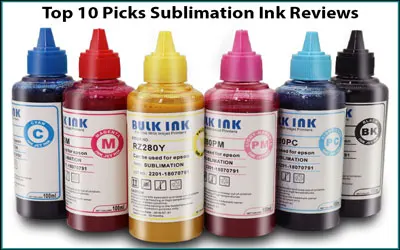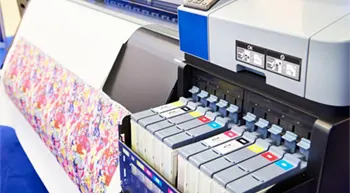Not only is sublimation printing a great option for bold images, but it also produces long-lasting results, which is one reason why it’s such a popular printing method.
Part of the reason why results last long are due to the type of ink that’s used – sublimation ink. But what is sublimation ink?
Sublimation ink is made from dye particles that are ground and mixed into a liquid.
This ink is printed onto transfer paper, which is then placed on the fabric or object you are printing on and heated, transferring the ink to the object.
There are also various types of sublimation ink, each with its own pros and cons.
What is Sublimation Printing?

Before we explain the different best sublimation ink types, it’s helpful to start with a brief explanation of what sublimation printing is.
Essentially, sublimation printing is a unique type of printing that involves the use of specialized inks made from dye particles.
These inks are ground and then added to a liquid, which helps carry them onto the desired surface.
Typically, you can use the various types of sublimation ink from an inkjet printer, which will then print on a specialized sublimation paper.
The printing process causes the dye particles within the liquid to heat up and vaporize into a gaseous form.
This heated and gaseous dye will then permeate the printing surface, resulting in high-quality images fused to the desired printing surface.
During the printing process, one color is printed at a time, which is part of the reason why the colors are so bright and distinct.
A final coat of a substrate is passed over the surface after all of the colored inks are applied to help seal everything in, giving the image a glossy and even brighter appearance.
What’s the Process?

You do not use sublimation ink for direct printing.
Instead, sublimation inks and a sublimation printer are used to print reverse images on the best sublimation paper.
Once this is complete, the printed sublimation ink on the paper is transferred onto the desired surface using a heat press.
In most cases, the final surface is an article of clothing.
More specifically, clothing that contains polyester fabric, as the inks cling to this particular material easier.
With that said, you can also print on polymer-treated objects, like glass, plastic, fiberglass, and aluminum, so sublimation ink is often used to print home décor and advertising displays.
What are the Main Types of Sublimation Ink?

There are two main types of sublimation ink:
- Aqueous dye sublimation ink
- Solvent dye sublimation ink
To help you understand the difference, we are going to go over a brief description of both types of ink, as well as describe what each type is primarily used for.
Aqueous Dye Sublimation Ink
With aqueous dye sublimation ink, the solvent is used to suspend the pigments and other vital ingredients in water.
Depending on the brand and the color, the ink can consist of 30 to 95% water.
The dye particles often only make up 1 to 10%of the volume of the ink.
This type of sublimation ink has a melting point of 200 degrees Celsius, or 392 degrees Fahrenheit, so the printing process involves extremely hot temperatures.
Since the printing process involves heating the aqueous dye sublimation ink to such extreme temperatures, you need to use a larger printer that can handle the task.
Typically, you will use a desktop printer or another type of large format sublimation printer for t-shirts to print the aqueous dye sublimation ink onto the appropriate sublimation paper.
Solvent Dye Sublimation Ink
The other main type of sublimation ink is fairly similar to aqueous dye sublimation ink, but the pigment particles are suspended in an oil base rather than a water base.
They also contain chloride-vinyl acetate and a variety of stabilizers and surfactants.
To use this type of sublimation ink, you must use an inkjet printer that can mix the ink as it is being printed, such as XAAR, Spectra, and certain Konica printhead wide-format printers.
This type of ink is ideal for designing and printing designs that involve vibrant colors and precise details.
Are There Any Disadvantages of Using Sublimation Ink?

While the benefits of using sublimation ink are fairly well known, few people understand some of the potential drawbacks of the sublimation process.
The following are some of the disadvantages of this type of printing:
- Sublimation ink involves a fairly complex printing process, and it is extremely temperature-dependent, so it tends to work best in a very controlled environment. This is not always an option for printing businesses that are just starting.
- To create high-quality images, you have to be printing on light-colored materials, such as a white T-shirt.
- For the image to come out clean, you can only really print on fabrics with at least 50 percent polyester, as the high temperatures required to heat the ink can damage other types of fabric, like cotton.
If you’re not printing a garment, you also need to ensure that the surface has been pre-applied with a polyester coating.
You must cover any metal, ceramic, glass, or wood surface in polyester before you can start printing.
This can be time-consuming and even somewhat expensive, but it is necessary if you’re dye-sublimation printing on mugs or other hard objects.
Is Sublimation Ink Better than Traditional Ink?
When printed properly and on an appropriate surface, the dyes contained within sublimation ink tend to produce much brighter and crisper images than conventional inks.
Why Print with Sublimation Ink?
While it can be more complicated than other types of printing, and the ink can be more expensive than the basic inks used in heat transfer printing, sublimation ink tends to last much longer.
The ink dyes adhere to the surface of the garment or object you print on, so your design lasts for many years.